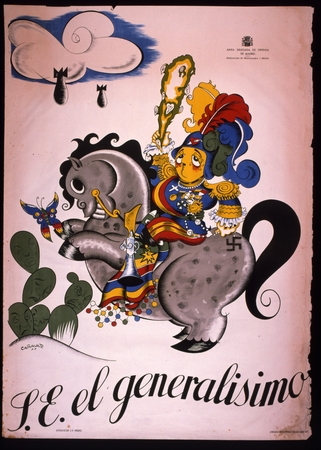S.E. el generalísimo
His Excellency, the Generalissimo
- Collection
- Description
-
As bombs fall from the sky, an effeminate Franco upon a fanciful horse raises a gnarly club against frowning and angry faces. The general is decked in a plumed helmet, cross necklace, Hitler button, and rosary beads with a swastika pendant
Like poster 36 in this exhibit, this poster is one of a small group of posters that employ sarcasm and caricature in their depiction of the major figures and themes of the Spanish Civil War. Facundo Tomás, author of Los Carteles Valencianos en la Guerra Civil Española, estimates that posters using the techniques of sarcasm or caricature account for not more than 3% of all the posters produced in Republican Spain during the war. While the majority of these posters satirized the Nationalist Spain and its political figures, the policies and practices of the Republican government were occasionally fodder for the satire and caricatures of artists working for the various associations in Republican Spain.
In this poster, the artist, Antonio Cañavate Gomez, has chosen General Francisco Franco, leader of Nationalist Spain, as the main target. Facundo Tomás explains that the central figure of the rider on the horse is reminiscent of the caballo de bastos (knight of clubs) that appears on Spanish playing cards. Consequently, the club that Franco clasps in his right hand is symbolic of both the caricature of him and of the violent and repressive nature of Franco's leadership.
The caricature of Franco is also evident in exaggeration of Franco's body type - short and round. As Tomás explains Spanish artists often employed the artistic trope of having a horse mimic or reflect the characteristics of the rider. The most famous example, of this trope, is Don Quixote and his "horse" Rocinante. In this poster here, there is a metonymic identification of Franco with his horse that exhibits the same exaggerated roundness as his rider. The bombs falling in the background also echo the physical characteristics of the scene's central figure.
Further interpretation can be made of the horse's smile. Once again, Tomás interprets the horse's smile as "sadistic and ruthless" in the sense that the horse participates in the atrocities of Franco, as the horse rears up to crush the anthropomorphic cacti with faces expressing suffering and fear, without losing its smile. Apparently, the cacti in the bottom left corner are representative of Franco's victims.
As to Franco himself, several interpreters of the poster have suggested that the artist intends for Franco to appear affected and effeminate. In fact, Facundo Tomás suggests that Cañavate is attempting to portray Franco as a homosexual. It is a move that inverts the trope of manliness and strength for describing or portraying soldiers during the Spanish Civil War. Specifically, Tomás points to the feathers in Franco's cap, his large eyelashes, his rosy cheeks, the pleats on the cuffs of his jacket, the effeminate position of his body, and, even, the eyelashes and carefully brushed mane of the horse. In addition, Tomás notes that Franco and his horse seem to be chasing a butterfly (In some Spanish dialects, the word for butterfly, mariposa, is slang for an effeminate man or homosexual.)
Other notable characteristics of this image of Franco are his pearl necklace with a cross and a picture of Hitler that appears among the medals on Franco's chest. In addition, the swastika on the horse's rump makes Franco's association with Nazi Germany abundantly clear.
As to the artist, little is know of Antonio Cañavate Gómez. He was born in Hellin and worked exclusively for the Junta de Defensa de Madrid (Committee for the Defense of Madrid). At least one other poster from the civil war can is definitively att - Creation Date
- between 1936 and 1939
- Creators
- Physical Description
-
1 print (poster) : lithograph, 5 cols. ; sheet 112 x 80 cm
- Geographics
- Genres
- Personal Name
- Topics
Format
View formats within this collection
- Identifier
-
Mms: 991000018569706535
- Related Resource
Online exhibit
- Classification
-
DP269.15.C358 1936
- Publication
-
Madrid?, Junta Delegada de Defensa de Madrid, Delegación de Propaganda y Prensa (sp)
- Copyright
-
Unknown
Use: This work is available from the UC San Diego Library. This digital copy of the work is intended to support research, teaching, and private study.
Constraint(s) on Use: This work may be protected by the U.S. Copyright Law (Title 17, U.S.C.). Use of this work beyond that allowed by "fair use" requires written permission of the copyright holder(s). Responsibility for obtaining permissions and any use and distribution of this work rests exclusively with the user and not the UC San Diego Library. Inquiries can be made to the UC San Diego Library program having custody of the work.
- Digital Object Made Available By
-
Special Collections & Archives, UC San Diego, La Jolla, 92093-0175 (https://lib.ucsd.edu/sca)
- Last Modified
2024-07-19
 Library Digital Collections
Library Digital Collections
